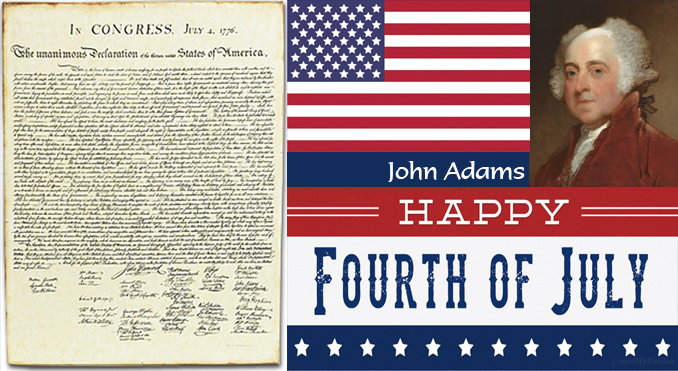
The Declaration of Independence
We celebrate American Independence Day on the Fourth of July every year. We think of July 4, 1776, as a day that represents the Declaration of Independence and the birth of the United States of America as an independent nation.
But July 4, 1776 wasn’t the day that the Continental Congress decided to declare independence (they did that on July 2, 1776).
It wasn’t the day we started the American Revolution either (that had happened back in April 1775).
And it wasn’t the day Thomas Jefferson wrote the first draft of the Declaration of Independence (that was in June 1776). Or the date on which the Declaration was delivered to Great Britain (that didn’t happen until November 1776). Or the date it was signed (that was August 2, 1776).
So what did happen on July 4, 1776?
The Continental Congress approved the final wording of the Declaration of Independence on July 4, 1776. They’d been working on it for a couple of days after the draft was submitted on July 2nd and finally agreed on all of the edits and changes.
July 4, 1776, became the date that was included on the Declaration of Independence, and the fancy handwritten copy that was signed in August (the copy now displayed at the National Archives in Washington, D.C.) It’s also the date that was printed on the Dunlap Broadsides, the original printed copies of the Declaration that were circulated throughout the new nation. So when people thought of the Declaration of Independence, July 4, 1776 was the date they remembered.
In contrast, we celebrate Constitution Day on September 17th of each year, the anniversary of the date the Constitution was signed, not the anniversary of the date it was approved. If we’d followed this same approach for the Declaration of Independence we’d being celebrating Independence Day on August 2nd of each year, the day the Declaration of Independence was signed!
How did the Fourth of July become a national holiday?
For the first 15 or 20 years after the Declaration was written, people didn’t celebrate it much on any date. It was too new and too much else was happening in the young nation. By the 1790s, a time of bitter partisan conflicts, the Declaration had become controversial. One party, the Democratic-Republicans, admired Jefferson and the Declaration. But the other party, the Federalists, thought the Declaration was too French and too anti-British, which went against their current policies.
By 1817, John Adams complained in a letter that America seemed uninterested in its past. But that would soon change.
After the War of 1812, the Federalist party began to come apart and the new parties of the 1820s and 1830s all considered themselves inheritors of Jefferson and the Democratic-Republicans. Printed copies of the Declaration began to circulate again, all with the date July 4, 1776, listed at the top. The deaths of Thomas Jefferson and John Adams on July 4, 1826, may even have helped to promote the idea of July 4 as an important date to be celebrated.
Celebrations of the Fourth of July became more common as the years went on and in 1870, almost a hundred years after the Declaration was written, Congress first declared July 4 to be a national holiday as part of a bill to officially recognize several holidays, including Christmas. Further legislation about national holidays, including July 4, was passed in 1939 and 1941.
Courtesy of https://www.constitutionfacts.com/
The Torch of Freedom…John Adams
“The Second Day of July 1776, will be the most memorable Epocha, in the History of America. I am apt to believe that it will be celebrated, by succeeding Generations, as the great anniversary Festival. It ought to be commemorated, as the Day of Deliverance by solemn Acts of Devotion to God Almighty. It ought to be solemnized with Pomp and Parade, with Shews, Games, Sports, Guns, Bells, Bonfires and Illuminations from one End of this Continent to the other from this Time forward forever more. You will think me transported with Enthusiasm but I am not. I am well aware of the Toil and Blood and Treasure, that it will cost Us to maintain this Declaration, and support and defend these States. Yet through all the Gloom I can see the Rays of ravishing Light and Glory. I can see that the End is more than worth all the Means. And that Posterity will tryumph in that Days Transaction, even altho We should rue it, which I trust in God We shall not.”
– John Adams July 3, 1776
This quote is an excerpt from John Adams’ letter to his wife Abigail on July 3, 1776. The emotions of this sharp-witted founding father speak of the momentous occasion. Adams believed that July 2, 1776, would be the date to mark and celebrate forever our Declaration of Independence. Although the official date comes later, Americans have celebrated their country’s birth date, and have followed Adams’ advice ever since. Adams bore witness to, and was part of, the American dream for freedom. He was an example of how the new nation would carry on after the war by becoming our first vice-president, and our second president. Adams’ eloquent words put the historical significance of American independence, and the consequence for failure if it was not achieved, into focus.

